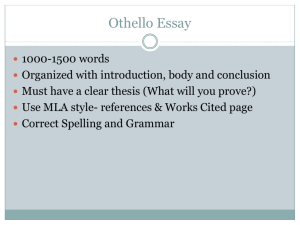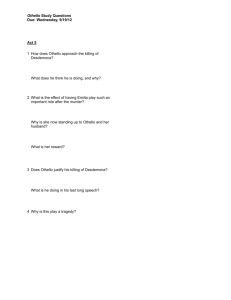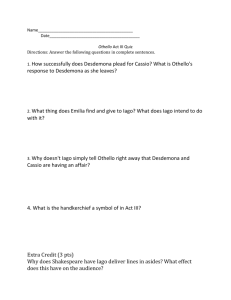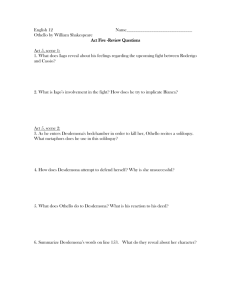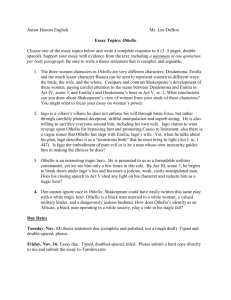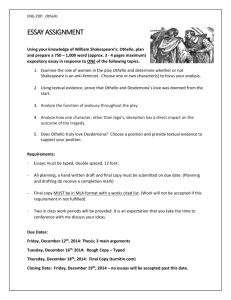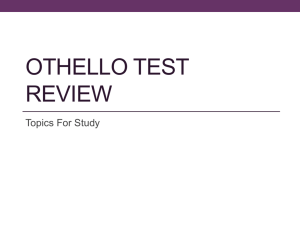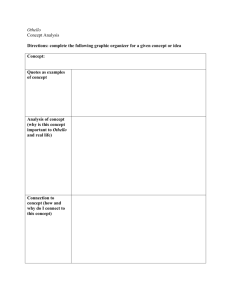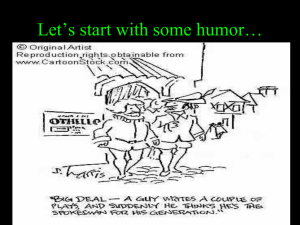Othello
advertisement
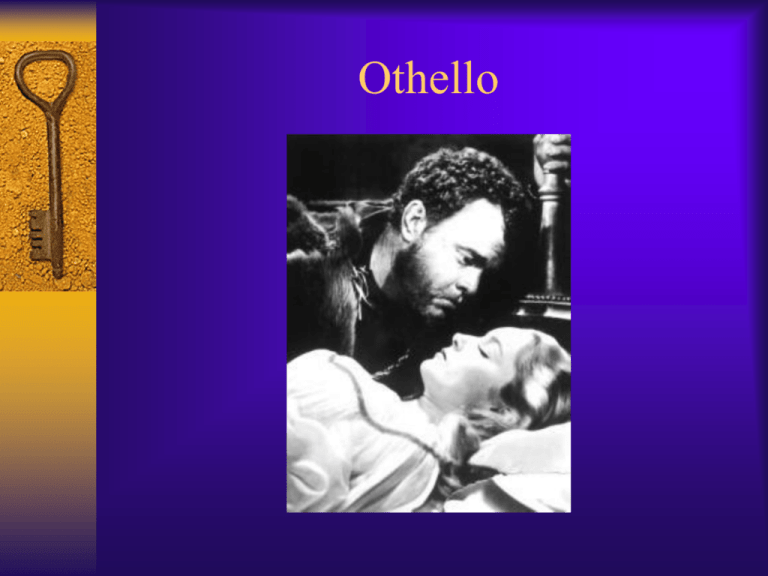
Othello William Shakespeare 1604 First performed November 1, 1604 for King James I. Written during Shakespeare’s great tragic period (Hamlet, King Lear, Macbeth) Shakespearean tragedy involves human character above all else. It is the fall of one person – the “Hero” who is of a high degree in society, with his fate affecting the welfare of the whole nation. What is the tragedy? A tale of suffering and calamity that leads up to and includes the death of the hero His misery is exceptional as it extends beyond him to the whole environment The hero’s fall, which is caused by some evil force, contrasts the powerlessness of man in the face of the caprice of Fate Where does it come from? The tragedy issues from conflict, either between persons or groups or forces within the hero’s soul The calamities of tragedy proceed from the actions of men; tragedy being caused by a series of deeds leading to a catastrophe The Tragic Hero He is a man of noble character and is depicted as somewhat larger than life. The events of the play must happen to a conspicuous person, and they are contrasted with his previous happiness or glory The character of the tragic hero must be complex because the tragedy lies, not in his death which is looked on as a relief or escape, but in his life. Hamartia or Tragic Flaw The main source of the tragic situation is moral evil which reveals itself in defects of character – irresolution (Hamlet), ambition (Macbeth), jealousy (Othello), rashness (Lear). The evil may grow worse and infect the entire figure of the leading figure (Macbeth) or it may become better and purge itself by suffering (Lear) Tragic Flaw continued What continues to motivate the tragic hero is generally his basic goodness and the tragic situation is ironic because the tragedy largely stems from the depiction of the waste of this good The tragic flaw is not always a simple one , although the evil is more often than not identified with one flaw Catharsis Through the fall of the tragic hero and the events of the tragedy, the audience is able to experience catharsis. Catharsis is a purging of emotion (usually pity) by vicariously experiencing the events of the play Due to the universal themes of Shakespeare’s plays (love, hate, jealousy, revenge, etc) a connection between a character, event or theme is almost guaranteed The Play Othello The play is set against the backdrop of the wars between Venice and Turkey from the latter part of the sixteenth century The island of Cyprus, the major setting for the play, became subservient to Venice in 1471 Cyprus was attacked by the Turks in 1570 and conquered the following year Sources The History of the Turks by Richard Knolles (1603) and the Italian tale by Giovanni Battista Giraldi Cinzio Both stories deal with the character Othello and work with similar themes Shakespeare added characters and took the minor character of the “ancient” and created one of his greatest villains in Iago The Moor The origin of Othello’s roots are unsure as he could have been of African or Arabic descent Moorish characters are evident in other Shakespearian plays (Titus Andronicus) but none as heroic as Othello. Although loved by most, the stereotypical racism in the play that looms below the surface is clearly shown by Iago Themes Illusion vs. reality; truth vs. falsehood Evil masquerading as good Friendship and betrayal Destruction of jealousy; unchecked passion Loyalty, trust vs. treachery Prejudice Love and Hate Characters Othello- General, husband to Desdemona Desdemona – Othello’s wife, daughter of Brabantio Iago – ancient to Othello Brabantio – Senator, father of Desdemona Cassio – Othello’s lieutenant Roderigo – pawn of Iago, fromer suitor of Desdemona Emilia – wife of Iago, Desdemona’s lady
